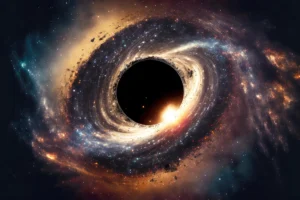Supermassive Black Hole Flashes Twice in Rare Cosmic Event: Scientists Explain Why

Astronomers have observed a rare phenomenon involving a supermassive black hole located 408 million light-years away. This black hole consumed a star from a binary system while its companion narrowly escaped. The event, known as a double-flash tidal disruption event (TDE), occurred in the galaxy WISEA J122045.05+493304.7. Typically, TDEs produce a single flare, but this one, designated ASASSN-22ci, is remarkable for its two flares, offering new insights into black hole behavior.
A Rare Double-Flare TDE
First detected in February 2022, ASASSN-22ci initially appeared to be a standard TDE, according to a study on arXiv. However, a second flare was observed 720 days later, making it one of the few documented cases of repeated TDEs.
Scientists suggest this phenomenon may result from a process called Hills capture. In such cases, a supermassive black hole disrupts a binary star system, ejecting one star at high velocity while the other remains trapped in an elongated orbit, undergoing multiple tidal disruptions.
Investigating the Black Hole and Star
Data from ultraviolet and X-ray observations indicate that the black hole has a mass approximately three million times that of the Sun. The star involved in the event likely has a mass similar to the Sun, though it is unclear if it had a companion that escaped. Researchers believe the two flares likely originated from the same star being disrupted twice during its orbit.
A Possible Third Flare in 2026
Scientists predict a third flare could occur in early 2026 if the star survives another close approach to the black hole. Such an event would provide a rare opportunity to study the early stages of a TDE, offering valuable insights into the interactions between black holes and nearby stars.








